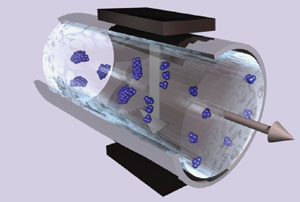| Posted: November 8, 2008 |
Magnetic solution for sticky nanoparticles problem |
|
(Nanowerk News) Belgian scientists have discovered a new method to stop nanoparticles sticking together. The method will improve the use of nanoparticles in applications ranging from suncream to catalysis, they claim.
|
|
A nanoparticle's small size and large surface area give it improved properties over bulk solids in a number of applications. But nanoparticles have a tendency to aggregate, which reduces their surface area and makes them behave more like the bulk material. A magnetic field could solve the problem, claim Johan Martens and colleagues at the Catholic University of Leuven ("Magnetic field assisted nanoparticle dispersion" – free access article).
|
 |
| The magnetic field breaks up the aggregates, forming nanoparticles a fraction of the size
|
|
Martens suspended alumina and silica aggregates in a flowing solution within a stationary magnetic field. They found that the magnetic force broke up the aggregates, forming particles a fraction of the size.
|
|
According to Martens, the new dispersion method is simpler and more energy efficient than commonly used methods, such as ball milling and ultrasound.
|
|
'This is an important breakthrough for many of the real industrially relevant applications of nanomaterials,' says Luis Liz-Marzán, an expert in nanoparticles from the University of Vigo, Spain. 'It is a very elegant and efficient way to improve all these processes.'
|
|
Martens says the group plan to use the method to optimise particle dispersion in heterogeneous catalysis and pharmaceutical formulations.
|

